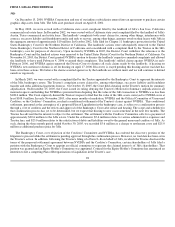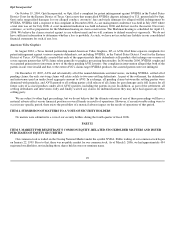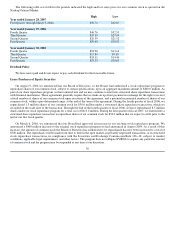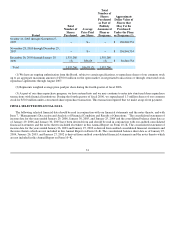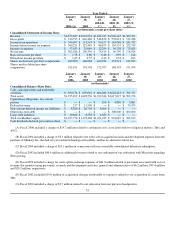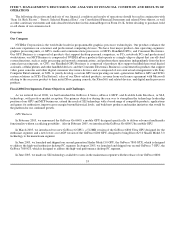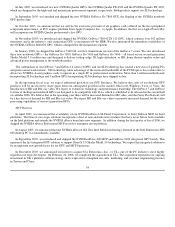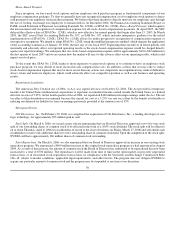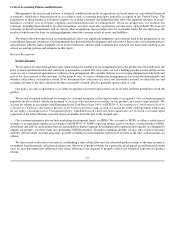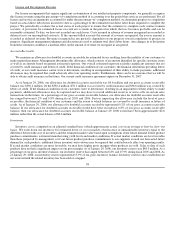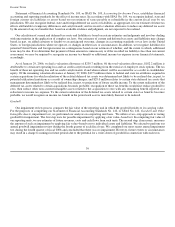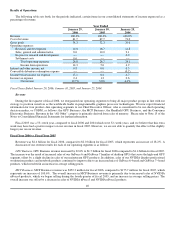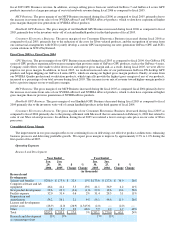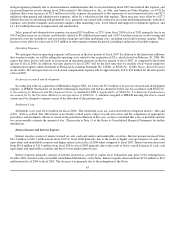NVIDIA 2006 Annual Report Download - page 44
Download and view the complete annual report
Please find page 44 of the 2006 NVIDIA annual report below. You can navigate through the pages in the report by either clicking on the pages listed below, or by using the keyword search tool below to find specific information within the annual report.
License and Development Revenue
For license arrangements that require significant customization of our intellectual property components, we generally recognize
this license revenue using the percentage−of−completion method of accounting over the period that services are performed. For all
license and service arrangements accounted for under the percentage−of−completion method, we determine progress to completion
based on actual direct labor hours incurred to date as a percentage of the estimated total direct labor hours required to complete the
project. We periodically evaluate the actual status of each project to ensure that the estimates to complete each contract remain
accurate. A provision for estimated losses on contracts is made in the period in which the loss becomes probable and can be
reasonably estimated. To date, we have not recorded any such losses. Costs incurred in advance of revenue recognized are recorded as
deferred costs on uncompleted contracts. If the amount billed exceeds the amount of revenue recognized, the excess amount is
recorded as deferred revenue. Revenue recognized in any period is dependent on our progress toward completion of projects in
progress. Significant management judgment and discretion are used to estimate total direct labor hours. Any changes in or deviations
from these estimates could have a material effect on the amount of revenue we recognize in any period.
Accounts Receivable
We maintain an allowance for doubtful accounts receivable for estimated losses resulting from the inability of our customers to
make required payments. Management determines this allowance, which consists of an amount identified for specific customer issues
as well as an amount based on general estimated exposure. Our overall estimated exposure excludes significant amounts that are
covered by credit insurance and letters of credit. If the financial condition of our customers, the financial institutions providing letters
of credit, or our credit insurance carrier were to deteriorate, resulting in an impairment of their ability to make payments, additional
allowances may be required that could adversely affect our operating results. Furthermore, there can be no assurance that we will be
able to obtain credit insurance in the future. Our current credit insurance agreement expires on December 31, 2007.
As of January 29, 2006, our allowance for doubtful accounts receivable was $0.6 million and our gross accounts receivable
balance was $330.4 million. Of the $330.4 million, $76.1 million was covered by credit insurance and $36.6 million was covered by
letters of credit. If the financial condition of our customers were to deteriorate, resulting in an impairment of their ability to make
payments, additional allowances may be required and we may have to record additional reserves or write−offs on certain sales
transactions in the future. As a percentage of our gross accounts receivable balance, our allowance for doubtful accounts receivable
has ranged between 0.2% and 0.8% during fiscal 2005 and 2006. Factors impacting the allowance include the level of gross
receivables, the financial condition of our customers and the extent to which balances are covered by credit insurance or letters of
credit. As of January 29, 2006, our allowance for doubtful accounts receivable represented 0.2% of our gross accounts receivable
balance. If our allowance for doubtful accounts receivable would have been recorded at 0.8% of our gross accounts receivable
balance, then our allowance for doubtful accounts receivable balance at January 29, 2006 would have been approximately $2.6
million, rather than the actual balance of $0.6 million.
Inventories
Inventory cost is computed on an adjusted standard basis (which approximates actual cost on an average or first−in, first−out
basis). We write down our inventory for estimated lower of cost or market, obsolescence or unmarketable inventory equal to the
difference between the cost of inventory and the estimated market value based upon assumptions about future demand, future product
purchase commitments, estimated manufacturing yield levels and market conditions. If actual market conditions are less favorable
than those projected by management, or if our future product purchase commitments to our suppliers exceed our forecasted future
demand for such products, additional future inventory write−downs may be required that could adversely affect our operating results.
If actual market conditions are more favorable, we may have higher gross margins when products are sold. Sales to date of such
products have not had a significant impact on our gross margin. As of January 29, 2006, our inventory reserve was $48.3 million. As a
percentage of our gross inventory balance, our inventory reserve has ranged between 8.8% and 15.9% during fiscal 2005 and 2006. As
of January 29, 2006, our inventory reserve represented 15.9% of our gross inventory balance. Inventory reserves once established are
not reversed until the related inventory has been sold or scrapped.
38


